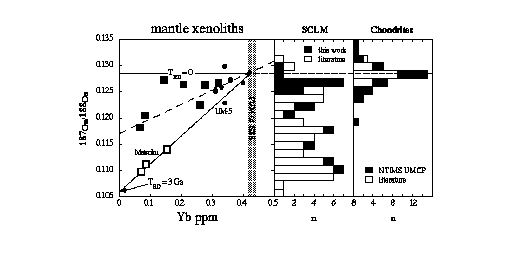
Over the past seven years studies of Os isotopes have promoted a better understanding of the development of subcontinental lithospheric mantle (SCLM). Unlike the isotopic systematics of lithophile elements, the siderophile Os is retained in the mantle during melting processes.The use of mantle xenoliths as SCLM probes provides information on the composition as well as timing of melt depletion events. Previous studies have concentrated on mantle xenoliths from Archean cratons, which have low, subchondritic Os isotopic compositions, indicating large amounts of ancient melt depletion, e.g., Kaapvaal, Wyoming and Siberia.
In this study we analyzed 19 well-characterized mantle xenolith samples (mostly from the BSVP study suite) from a variety of localities (SW-USA, Alaska, Mexico, Australia, China and S-Africa) with a range of fertility (1.27<Al2O3<4.29 wt%). The goals were: 1) to constrain further the global range in Os isotopic composition of SCLM, 2) to estimate the Os isotopic composition of undepleted upper mantle by extrapolation to primitive values or ratios of major and/or trace elements and 3) to constrain possible precursor materials that likely make up the primitive upper mantle (PUM) by comparing these data to analyses of meteorites.
The samples display a range in187Os/188Os from 0.1197 to 0.1298 (see Fig. 1). The new data on the most fertile SCLM samples extend the range of the Os isotopic compositions of SCLM to values that overlap the range of abyssal peridotites. Analyses of nine mantle xenoliths from Kilbourne Hole range from 0.1229 to 0.1298. The Os isotopic compositions are positively correlated with several melt depletion indicators, e.g., Al2O3. Such correlations have also been observed in orogenic peridotite massifs (Reisberg and Lorand, 1995).
A diagram of Yb vs. 187Os/188Os shows distinct linear correlations for localities of different ages. The correlations for Kilbourne Hole and Matsoku (Lesotho) can be extrapolated back to primitive values for Yb, yielding an Os isotopic composition for a modern day undepleted upper mantle of 0.1283±5. This value is the the equivalent of a hypothetical modern day PUM ratio. The intersections of these linear correlations with the y-axis yield 187Os/188Os that can be used to calculate "true" rhenium-depletion model ages (TRD), e.g., 3 Ga for the highly depleted Matsoku samples.
The modern day PUM value of 0.1283±5 is higher than existing high precision data for carbonaceous chondrites and average abyssal peridotites and is closer to ordinary and enstatite chondrite compositions. These results suggest that the modern day 187Os/188Os for PUM is more radiogenic than that of the source of modern MORB (as seen in abyssal peridotites) and may consequently reflect minor long-term depletion of Re in the MORB source.
Reisberg, L. & Lorand, J.-P., Nature 376, 159-162 (1995).
Fig. 1.